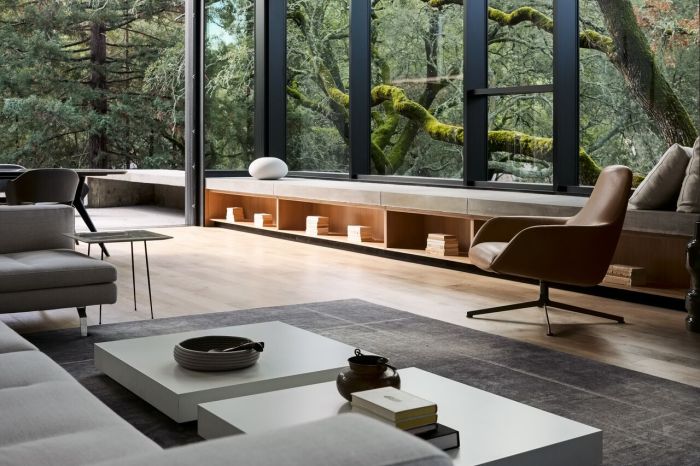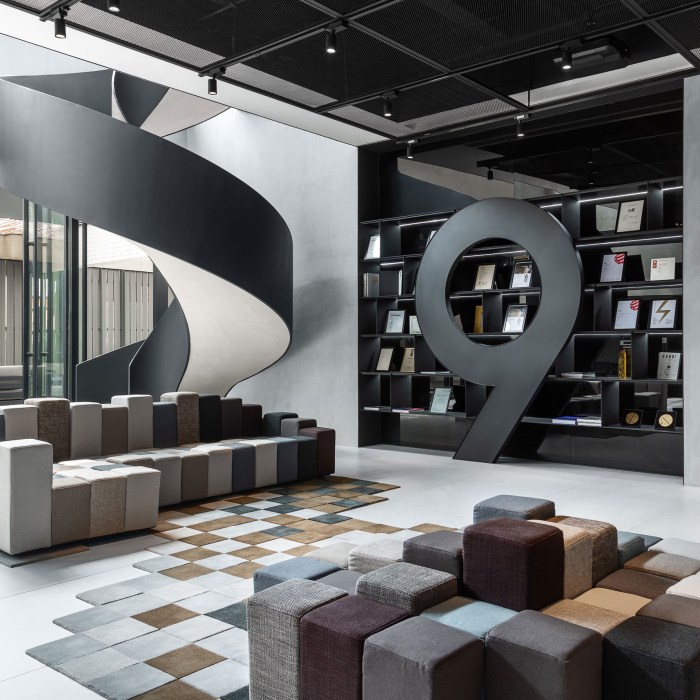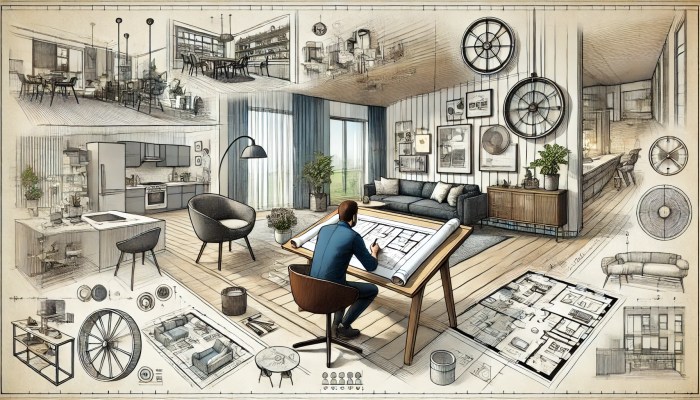Interior architecture sets the stage for this enthralling narrative, offering readers a glimpse into a story that is rich in detail and brimming with originality from the outset. As we delve into the intricate world of interior architecture, we uncover how spaces come to life through a delicate balance of design elements and principles.
From the fundamental concepts to the cutting-edge technologies shaping the field, the exploration of interior architecture promises a fascinating journey through the art and science of creating functional and aesthetically pleasing environments.
Overview of Interior Architecture

Interior architecture is the art and science of designing and enhancing the interior spaces of buildings. It focuses on creating functional, aesthetically pleasing environments that meet the needs and preferences of the occupants. Interior architects play a crucial role in shaping the way people experience and interact with the spaces around them.
Relationship between Interior Architecture and Spatial Design
Interior architecture and spatial design are closely interlinked disciplines that work together to optimize the use of space within a built environment. While interior architecture involves the structural elements, finishes, and furnishings of a space, spatial design focuses on the overall layout, circulation, and flow of that space.
Together, they ensure that the interior environment is both visually appealing and practical for its intended purpose.
Role of Interior Architects
Interior architects are responsible for translating a client's needs and vision into a cohesive design concept. They consider factors such as functionality, safety, sustainability, and aesthetics when planning and executing interior spaces. By collaborating with other design professionals, contractors, and suppliers, interior architects oversee the entire process from concept development to final implementation, ensuring that the end result is a well-designed space that enhances the quality of life for its users.
Elements of Interior Architecture
Interior architecture encompasses various key elements that work together to create a cohesive and functional space. These elements include lighting, materials, color schemes, and furniture, each playing a vital role in shaping the overall design aesthetic and functionality of a space.
Lighting
Lighting is a crucial element in interior architecture as it not only illuminates a space but also sets the mood and ambiance. Whether natural or artificial, the placement and type of lighting fixtures can greatly impact the look and feel of a room.
Innovative designs often incorporate a mix of ambient, task, and accent lighting to create layers of light that enhance the space.
Materials
Materials used in interior architecture, such as wood, glass, metal, and textiles, contribute to the tactile and visual experience of a space. The choice of materials can influence the overall style, durability, and sustainability of a design. Innovative designs often experiment with unconventional materials or sustainable options to create unique and environmentally-friendly spaces.
Color Schemes
Color plays a significant role in interior architecture by influencing the perception of space, mood, and functionality. Innovative designs carefully consider color psychology and trends to create harmonious or contrasting color schemes that enhance the overall design concept. From monochromatic palettes to bold contrasts, color choices can transform a space dramatically.
Furniture
Furniture selection is key in interior architecture as it not only provides functionality but also contributes to the aesthetic appeal of a space. Innovative designs often feature custom or multi-functional furniture pieces that maximize space and cater to specific user needs.
The arrangement and style of furniture can define the flow and purpose of different areas within a space.Innovative interior architecture designs that effectively incorporate these elements can be seen in projects like the Apple Store flagship locations, where sleek lighting fixtures, minimalist materials, carefully curated color schemes, and iconic furniture pieces come together to create a seamless and immersive retail experience.
Principles of Interior Architecture
Interior architecture relies on fundamental principles such as balance, harmony, rhythm, and emphasis to create functional and aesthetically pleasing spaces. These principles guide the decision-making process for interior architects, helping them achieve a cohesive design that meets the needs of the occupants while enhancing the overall atmosphere of the space.
Balance
Balance in interior architecture involves the distribution of visual weight in a space to create a sense of equilibrium. This can be achieved through symmetrical, asymmetrical, or radial balance, depending on the desired effect and function of the space.
Harmony
Harmony refers to the coordination and coherence of various design elements within a space. It ensures that different components work together seamlessly to create a unified and pleasing environment for the occupants.
Rhythm
Rhythm in interior architecture involves the repetition and variation of design elements to create a sense of movement and visual interest. It helps guide the eye through the space and can be achieved through patterns, colors, textures, or shapes.
Emphasis
Emphasis is used to highlight a focal point or key element within a space. It can draw attention to specific features, create hierarchy, and establish a visual hierarchy that enhances the overall design.These principles of interior architecture differ from traditional architecture principles in that they focus more on the human experience within a space, emphasizing functionality, comfort, and aesthetics to create environments that are both visually appealing and practical for daily use.
Technology in Interior Architecture

Technology plays a significant role in shaping the field of interior architecture, revolutionizing the way designers work and interact with clients. From 3D modeling to virtual reality and smart home systems, advancements in technology have enhanced the design process and transformed the way spaces are conceptualized and visualized.
Impact of 3D Modeling
D modeling has become a staple in interior architecture, allowing designers to create detailed and realistic renderings of spaces before construction even begins. This technology enables clients to visualize the final outcome more accurately, leading to better decision-making and design outcomes.
Virtual Reality in Design
Virtual reality has revolutionized the way clients experience interior spaces. Designers can now create immersive virtual tours, allowing clients to "walk through" the space and get a feel for the design before it is built. This technology enhances client engagement and understanding of the design concept.
Smart Home Systems Integration
Smart home systems have become increasingly popular in interior architecture, offering automation and integration of technology within living spaces. From lighting and temperature control to security systems, these technologies enhance the functionality and comfort of a space while adding a touch of modernity.
Cutting-Edge Technologies in Interior Architecture
In addition to 3D modeling, virtual reality, and smart home systems, other cutting-edge technologies are making their mark in interior architecture. For example, parametric design software allows for complex geometric forms to be created with ease, while sustainable technologies like green building materials and energy-efficient systems are being integrated into designs for a more environmentally friendly approach.
Ending Remarks

In conclusion, interior architecture stands as a testament to the seamless blend of creativity and functionality, where spaces transform into immersive experiences that captivate the senses. As we continue to push boundaries and embrace innovation, the evolution of interior architecture holds endless possibilities for crafting spaces that inspire and delight.
FAQ Summary
What is the significance of balance in interior architecture?
Balance in interior architecture ensures that visual weight is distributed evenly in a space, creating a sense of equilibrium and harmony.
How do interior architects incorporate technology into their designs?
Interior architects utilize technology like 3D modeling and virtual reality to visualize spaces and enhance client interactions during the design process.
What sets interior architecture apart from traditional architecture principles?
While traditional architecture focuses on exterior structures, interior architecture emphasizes the design of interior spaces to create functional and aesthetically pleasing environments.










